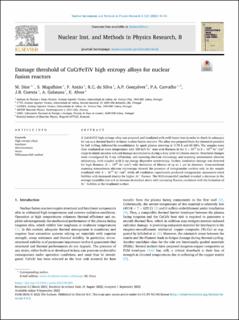| dc.contributor.author | Dias, M. | |
| dc.contributor.author | Magalhães, S. | |
| dc.contributor.author | Antão, F. | |
| dc.contributor.author | da Silva, Silva | |
| dc.contributor.author | Gonçalves, A.P. | |
| dc.contributor.author | Almeida Carvalho, Patricia | |
| dc.contributor.author | Correia, J.B. | |
| dc.contributor.author | Galatanu, A. | |
| dc.contributor.author | Alves, E. | |
| dc.date.accessioned | 2022-10-26T12:30:44Z | |
| dc.date.available | 2022-10-26T12:30:44Z | |
| dc.date.created | 2022-09-28T11:03:33Z | |
| dc.date.issued | 2022 | |
| dc.identifier.citation | Nuclear Instruments and Methods in Physics Reseach B. 2022, 529 49-55. | en_US |
| dc.identifier.issn | 0168-583X | |
| dc.identifier.uri | https://hdl.handle.net/11250/3028449 | |
| dc.description.abstract | A CuCrFeTiV high entropy alloy was prepared and irradiated with swift heavy ions in order to check its adequacy for use as a thermal barrier in future nuclear fusion reactors. The alloy was prepared from the elemental powders by ball milling, followed by consolidation by spark plasma sintering at 1178 K and 65 MPa. The samples were then irradiated at room temperature with 300 keV Ar+ ions with fluences in the 3 × 1015 to 3 × 1018 Ar+/cm2 range to mimic neutron-induced damage accumulation during a duty cycle of a fusion reactor. Structural changes were investigated by X-ray diffraction, and scanning electron microscopy and scanning transmission electron microscopy, both coupled with X-ray energy dispersive spectroscopy. Surface irradiation damage was detected for high fluences (3 × 1018 Ar+/cm2) with formation of blisters of up to 1 μm in diameter. Cross-sectional scanning transmission electron microscopy showed the presence of intergranular cavities only in the sample irradiated with 3 × 1018 Ar+/cm2, while all irradiation experiments produced intragranular nanometric-sized bubbles with increased density for higher Ar+ fluence. The Williamson-Hall method revealed a decrease in the average crystallite size and an increase in residual strain with increasing fluence, consistent with the formation of Ar+ bubbles at the irradiated surface. | en_US |
| dc.language.iso | eng | en_US |
| dc.publisher | Elsevier | en_US |
| dc.rights | Attribution-NonCommercial-NoDerivatives 4.0 Internasjonal | * |
| dc.rights.uri | http://creativecommons.org/licenses/by-nc-nd/4.0/deed.no | * |
| dc.subject | Williamson-Hall method | en_US |
| dc.subject | Strain | en_US |
| dc.subject | Microstructures | en_US |
| dc.subject | Interlayer | en_US |
| dc.subject | High entropy alloys | en_US |
| dc.title | Damage threshold of CuCrFeTiV high entropy alloys for nuclear fusion reactors | en_US |
| dc.title.alternative | Damage threshold of CuCrFeTiV high entropy alloys for nuclear fusion reactors | en_US |
| dc.type | Peer reviewed | en_US |
| dc.type | Journal article | en_US |
| dc.description.version | publishedVersion | en_US |
| dc.rights.holder | © 2022 The Authors. Published by Elsevier B.V | en_US |
| dc.source.pagenumber | 49-55 | en_US |
| dc.source.volume | 529 | en_US |
| dc.source.journal | Nuclear Instruments and Methods in Physics Reseach B | en_US |
| dc.identifier.doi | 10.1016/j.nimb.2022.09.003 | |
| dc.identifier.cristin | 2056262 | |
| cristin.ispublished | true | |
| cristin.fulltext | original | |
| cristin.qualitycode | 1 | |

